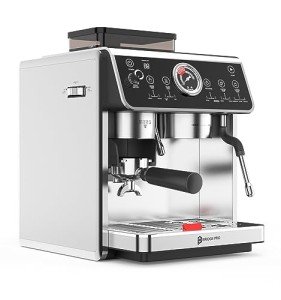The Ultimate Guide to Cappuccino Machines: Brewing the Perfect Cup
Cappuccinos are a precious coffee drink that integrates the abundant tastes of espresso with steamed milk and milk foam. For lots of, nothing tastes much better than a homemade cappuccino crafted with accuracy. Nevertheless, duplicating the ability of a barista at home requires the best equipment. This is where cappuccino machines enter into play. This article looks into the various kinds of cappuccino machines, how they work, and suggestions for choosing the best one for your needs.
What is a Cappuccino Machine?
A cappuccino machine is a customized developing gadget created to make coffees and other espresso-based drinks. These machines normally include a built-in espresso maker, a milk frother, and various controls for changing temperature and pressure. Cappuccino machines can be manual, semi-automatic, or fully automatic, offering different levels of user control depending upon the complexity of the machine.
Kinds Of Cappuccino Machines
1. Manual Espresso Machines
- Description: These machines require users to run most functions manually, consisting of grinding coffee beans, tamping the grounds, pulling the espresso shot, and frothing the milk.
- Pros:
- Offers complete control over the brewing procedure.
- Can produce high-quality, café-like espresso.
- Cons:
- Steeper learning curve.
- Requires more time and effort.
2. Semi-Automatic Espresso Machines
- Description: Semi-automatic machines automate some processes, such as water pressure. Espresso Machines Under £100 need to grind coffee and froth milk manually.
- Pros:
- Balanced control and convenience.
- Allows space for experimentation.
- Cons:
- Still requires practical skills.
- Can be complex for beginners.
3. Fully Automatic Espresso Machines
- Description: These machines automate the entire developing procedure, from grinding to frothing. Users just select the desired drink.
- Pros:
- Extremely convenient and simple to use.
- Consistent outcomes with little effort.
- Cons:
- More expensive.
- Limited control over the brewing procedure.
4. Super Automatic Espresso Machines
- Description: Similar to totally automatic machines, however these models consist of functions like a built-in milk frother and grinder. They prepare drinks with just the touch of a button.
- Pros:
- Ultimate convenience; makes numerous beverages rapidly.
- Integrated cleaning and maintenance functions.
- Cons:
- High initial cost.
- Less hands-on experience with coffee making.
Key Features to Consider
When choosing a cappuccino machine, several functions can considerably influence efficiency and user experience. Here are some necessary elements to assess:
1. Build Quality
- Products utilized (stainless steel, plastic)
- Durability and longevity
2. Capability
- Water tank size
- Bean hopper capability
3. Frothing Capability
- Type of frothing wand (manual, automatic)
- Steam pressure and temperature level control
4. Relieve of Use
- Intuitive controls
- Cleaning and maintenance requirements
5. Price
- Variety from budget to high-end designs
- Consider warranties and consumer assistance choices
6. Brand Reputation
- User reviews and expert viewpoints
- Availability of replacement parts
The Brewing Process
To brew the best cappuccino at home, follow this procedure, no matter the machine type:
- Prepare the Espresso: Use newly ground coffee beans and pull a double shot (roughly 2 ounces) of espresso.
- Froth the Milk: Steam fresh milk to a temperature about 150 ° F( 65 ° C)using the steam wand or automatic frother.
- Combine: Pour the steamed milk over the espresso, followed by a layer of milk foam (equal parts espresso and steamed milk, with about 1 cm of foam).
For a visual representation, here's a basic table comparing the qualities of the cappuccino machine types:
| Machine Type | Control Level | Relieve of Use | Rate Range | Ideal For |
|---|---|---|---|---|
| Manual Espresso Machine | High | Tough | Low to Medium | Coffee enthusiasts, purists |
| Semi-Automatic Machine | Medium | Moderate | Medium | Home baristas, hobbyists |
| Totally Automatic Machine | Low | Easy | Medium to High | Casual drinkers |
| Super Automatic Machine | Really Low | Really Easy | High | Hectic experts |
Regularly Asked Questions (FAQs)
What is the best milk to use for cappuccinos?
Entire milk is frequently preferred for frothing due to its fat material, which creates a creamy texture. Nevertheless, options like almond milk, oat milk, or soy milk can be used, though they might require various frothing methods.
How do I tidy my cappuccino machine?
The majority of machines come with specific cleansing guidelines. Normally, you must frequently clean the group head, steam wand, and drip tray. For automatic machines, lots of models feature self-cleaning cycles.
Can I use pre-ground coffee instead of whole beans?
Yes, you can use pre-ground coffee. However, newly ground coffee generally produces a more flavorful espresso due to the oils in the beans being preserved.
Just how much should I spend on a cappuccino machine?
The rate varies substantially based upon features, brand, and quality. A basic, great quality machine might start around ₤ 200, while high-end incredibly automatic machines can surpass ₤ 2,000.
How often should I replace my cappuccino machine?
With proper upkeep, a high-quality cappuccino machine can last for several years. However, you might consider updating if you discover your machine no longer meets your brewing needs or experiences performance problems.
Cappuccino machines are powerful allies in delivering the ideal brew in your home. Whether you prefer manual interaction with your coffee or choose the benefit of totally automated machines, comprehending the numerous types and their functions will help you in making the ideal choice. By purchasing the ideal machine for your needs and employing the right strategies, anybody can delight in a barista-quality cappuccino from the comfort of their own kitchen. With a bit of persistence and creativity, the art of cappuccino brewing can end up being a wonderful ritual, brewing not just coffee but moments of joy.

